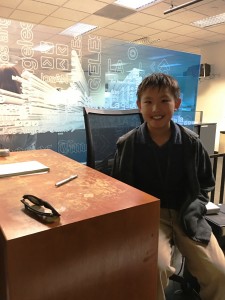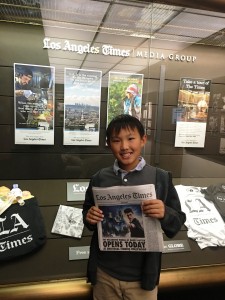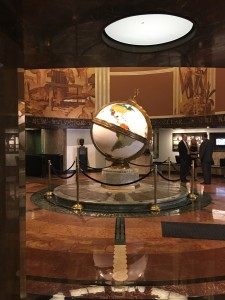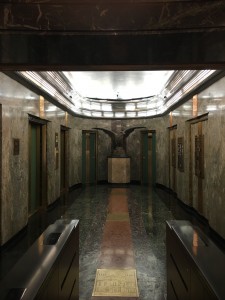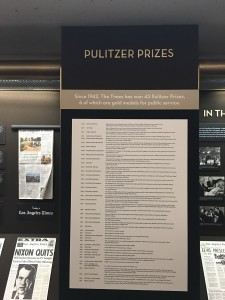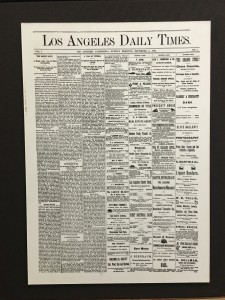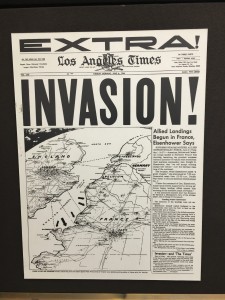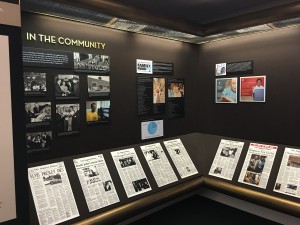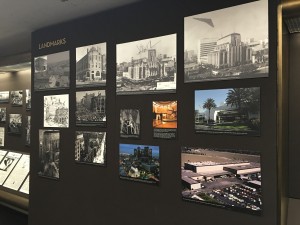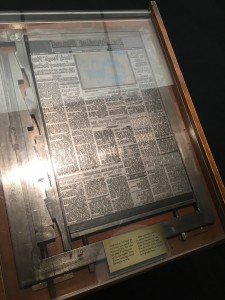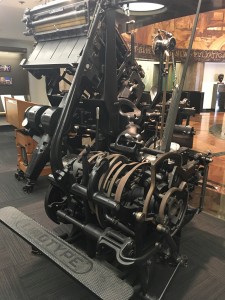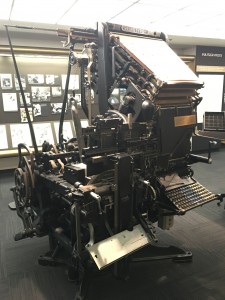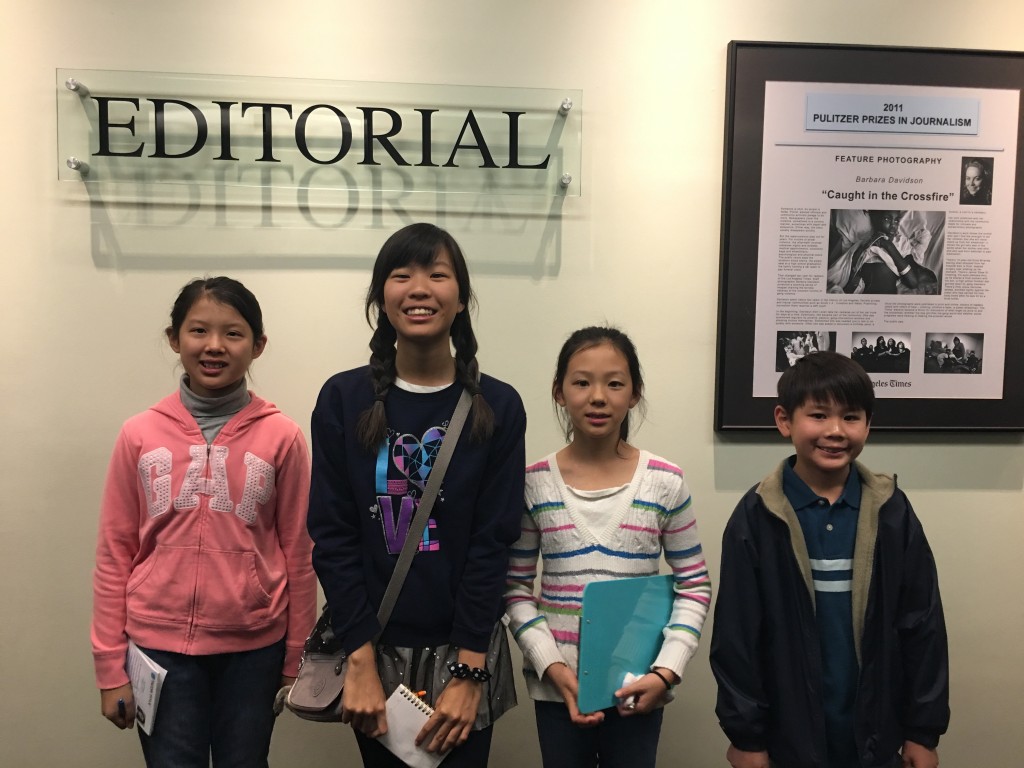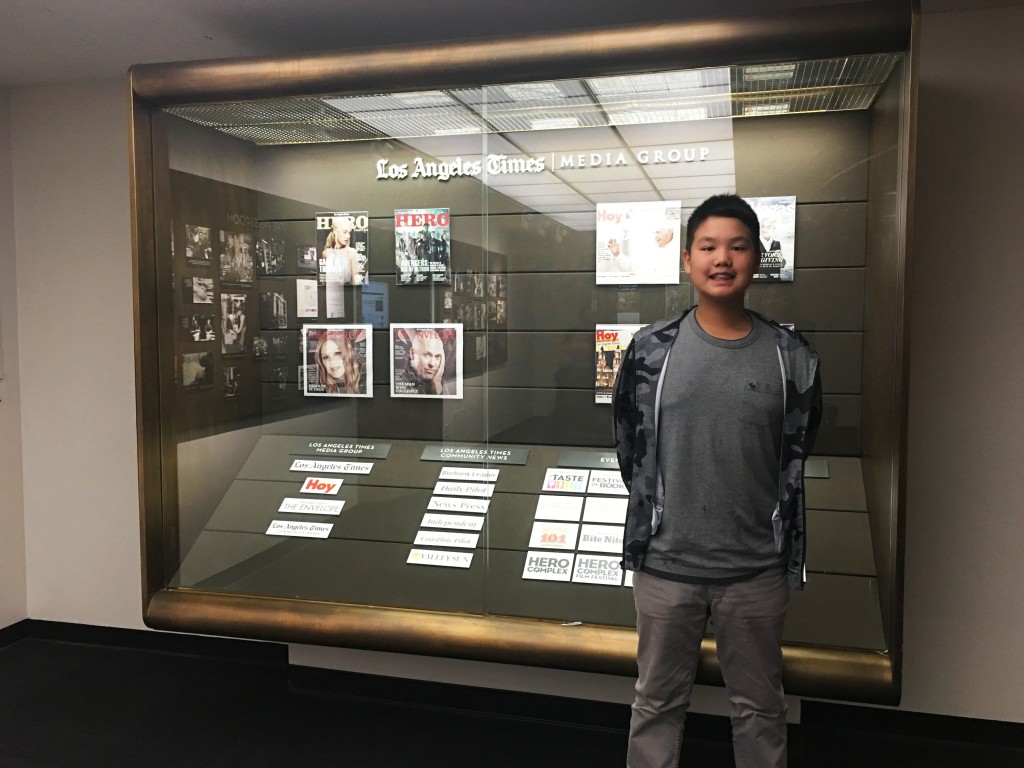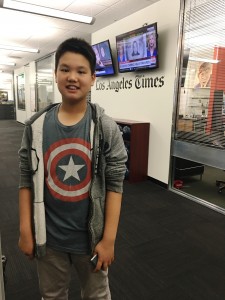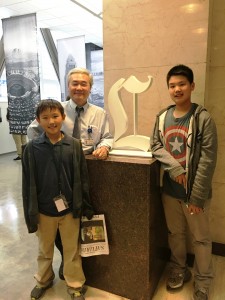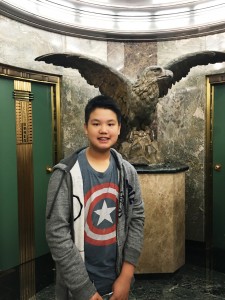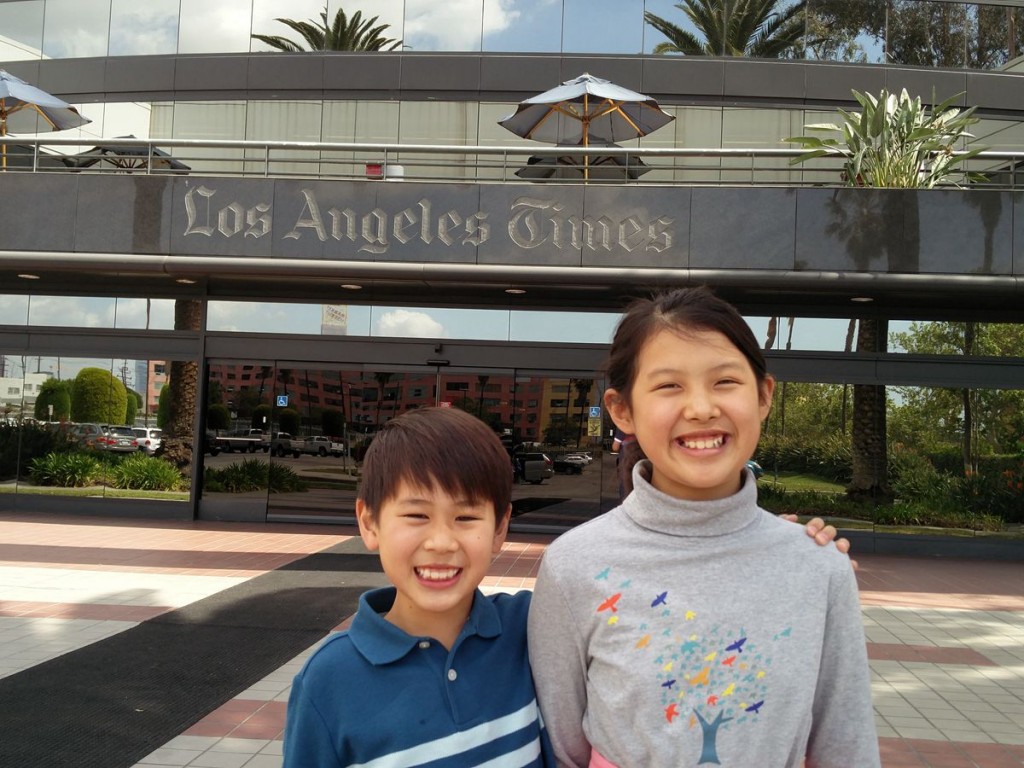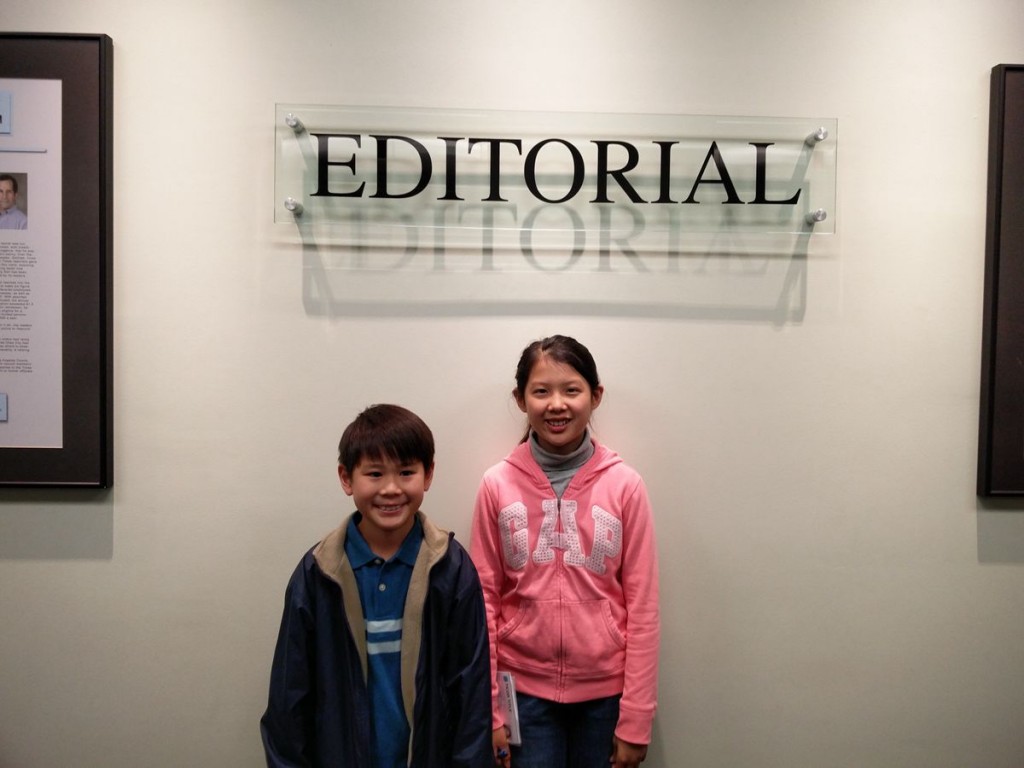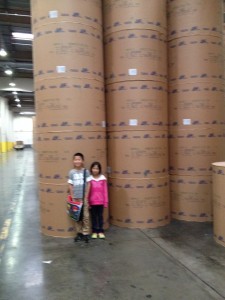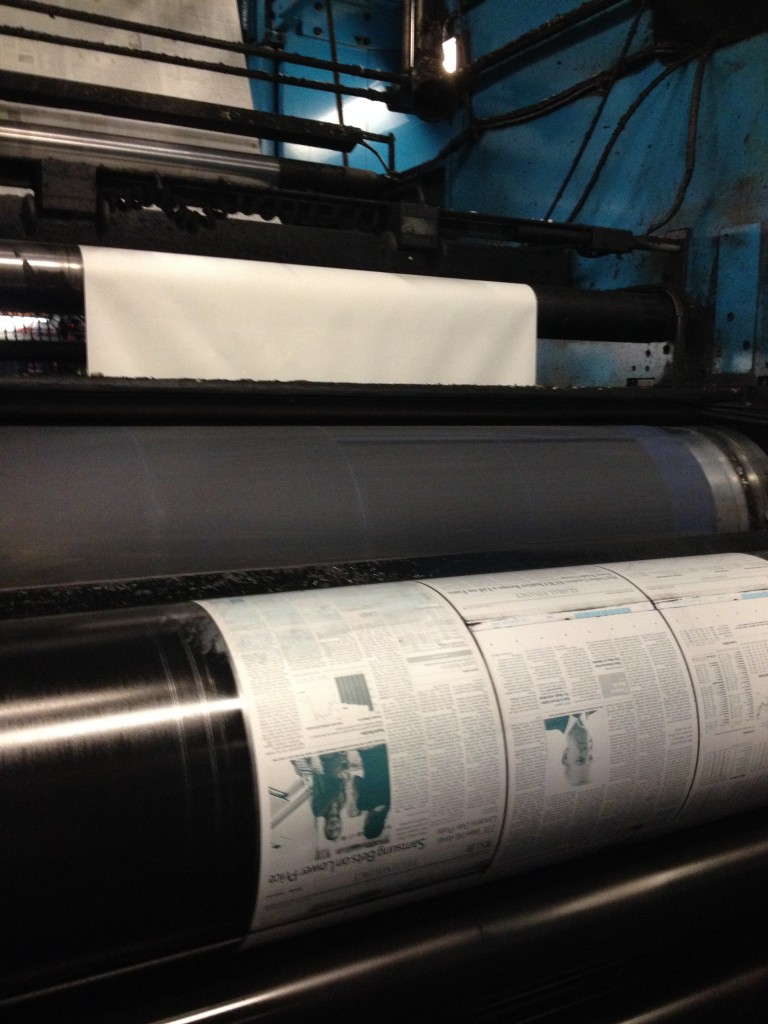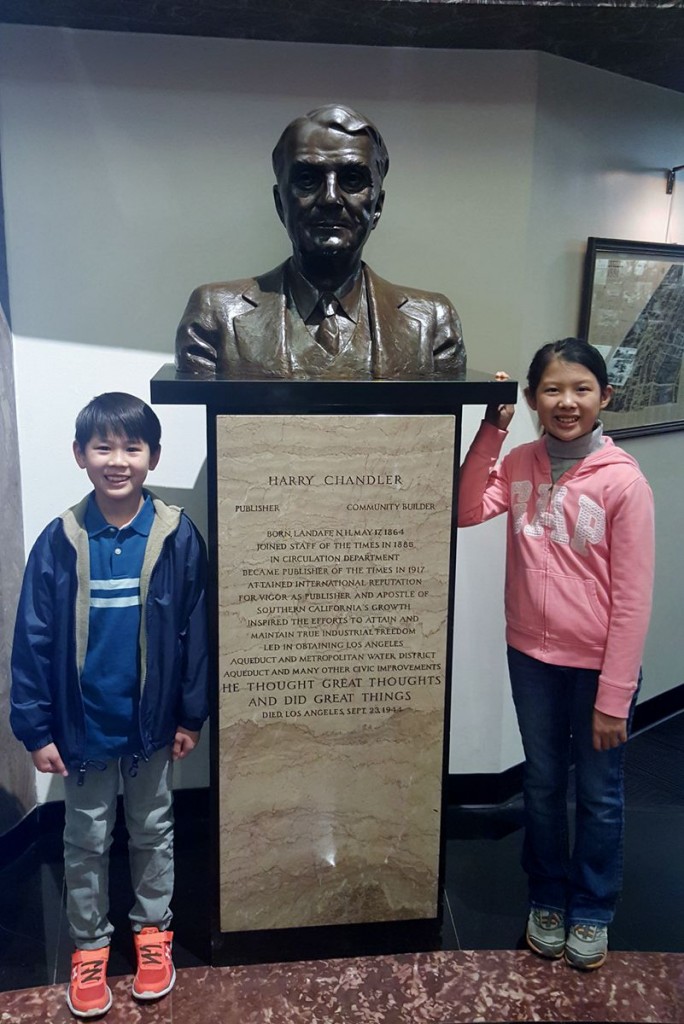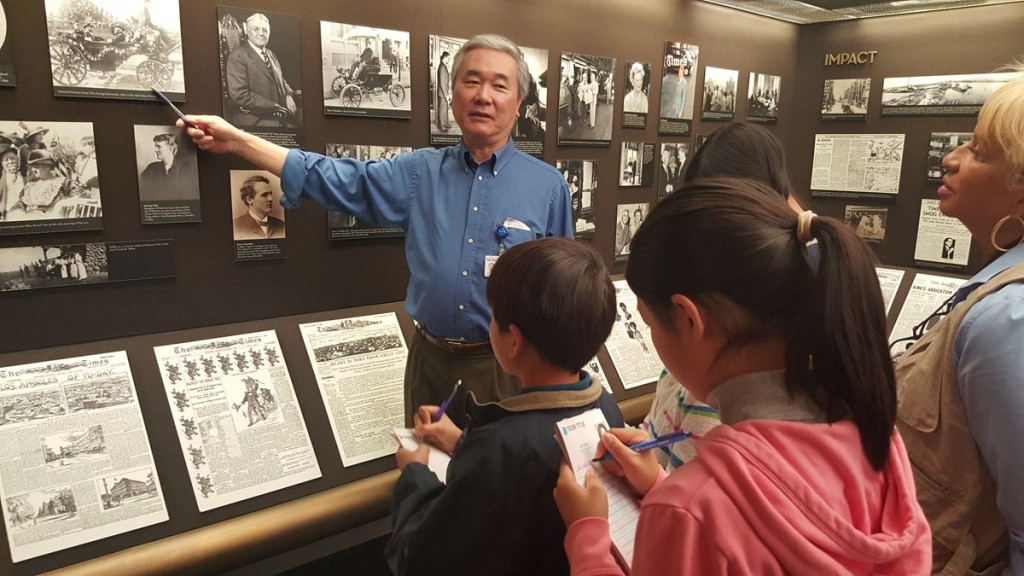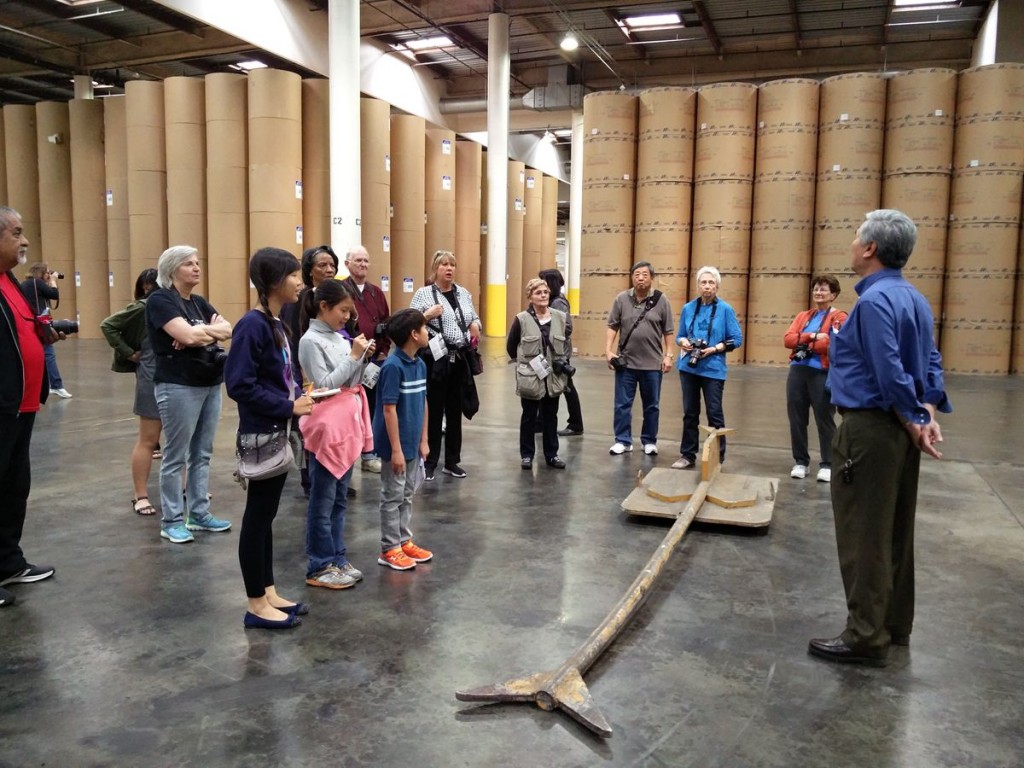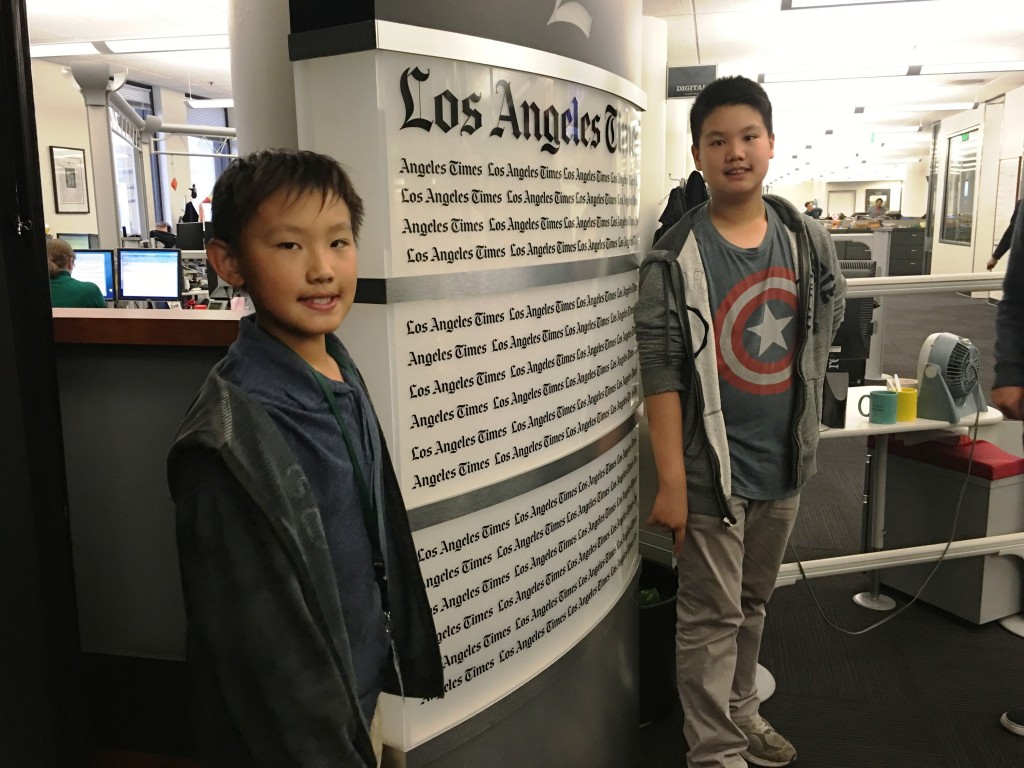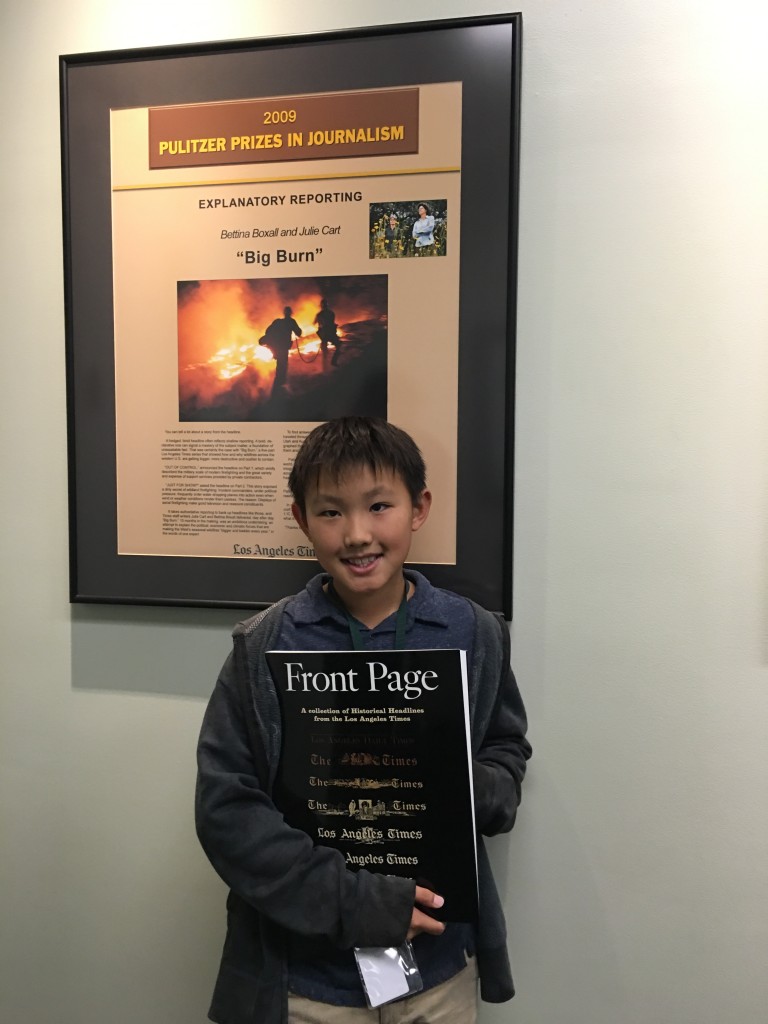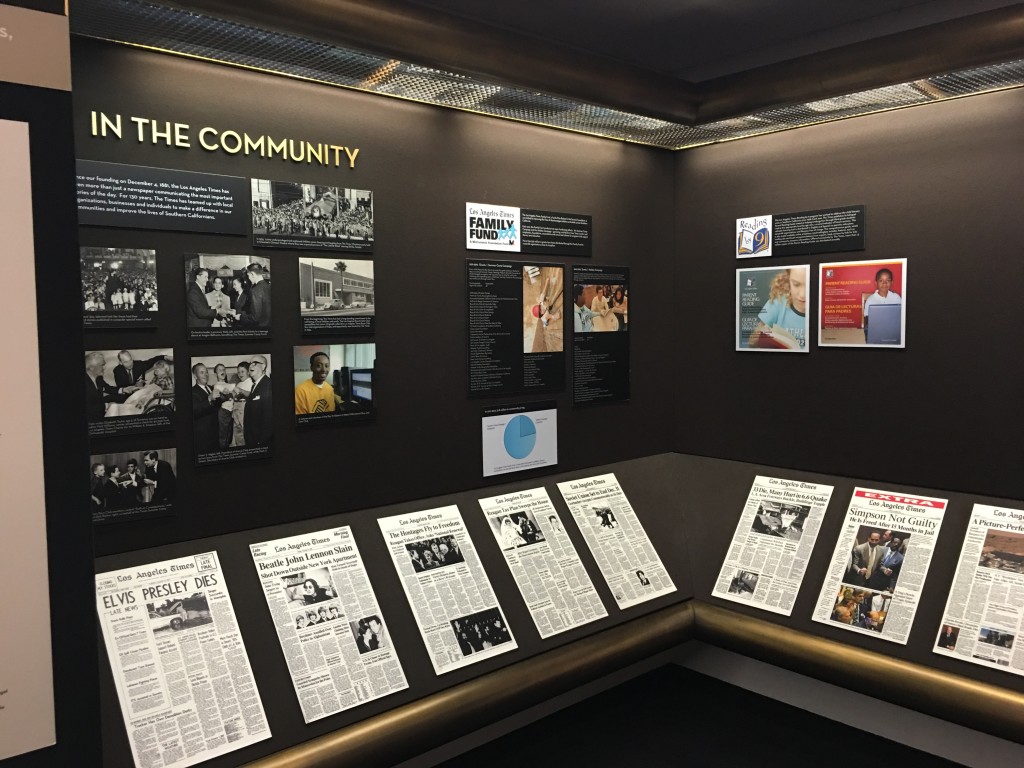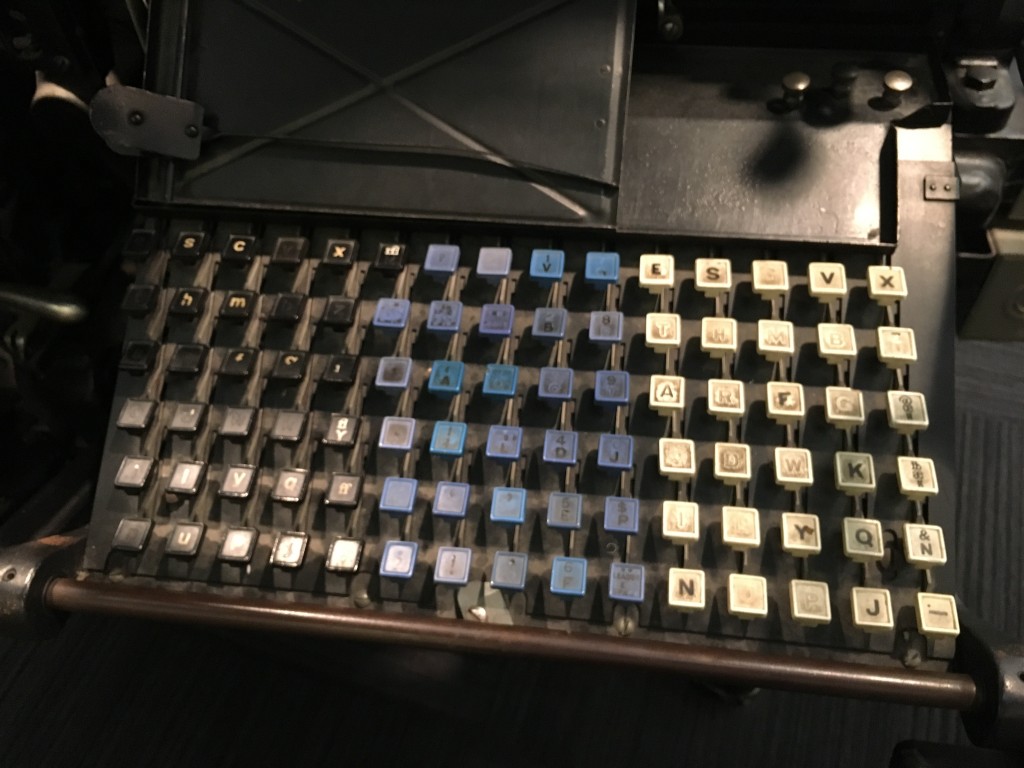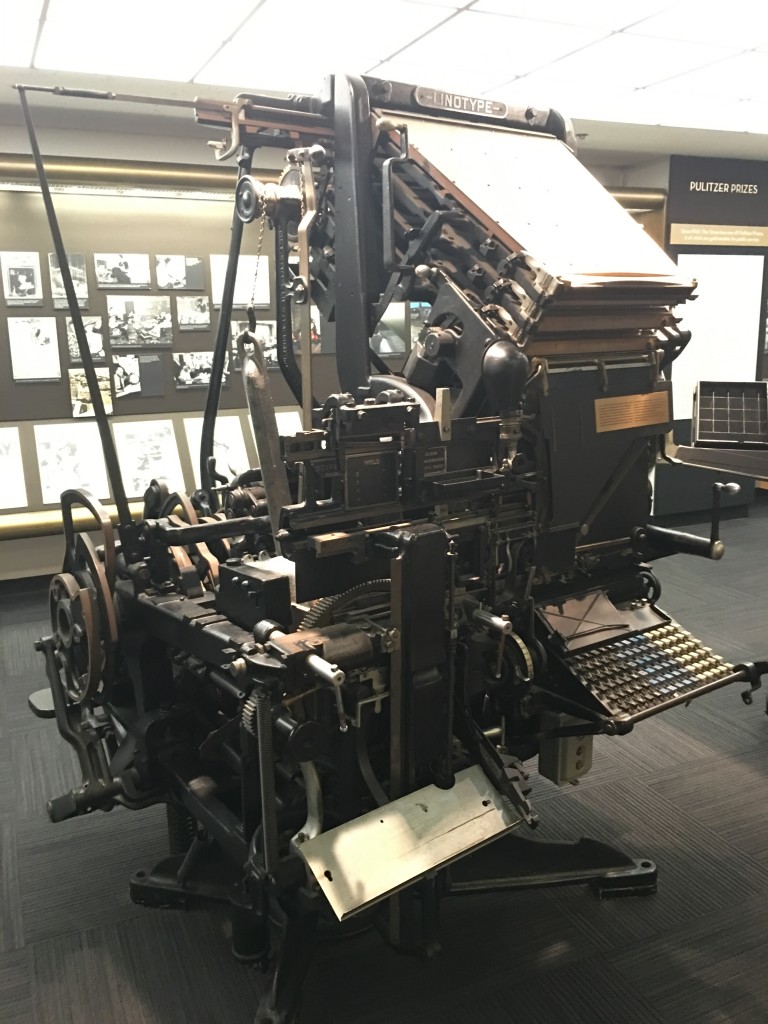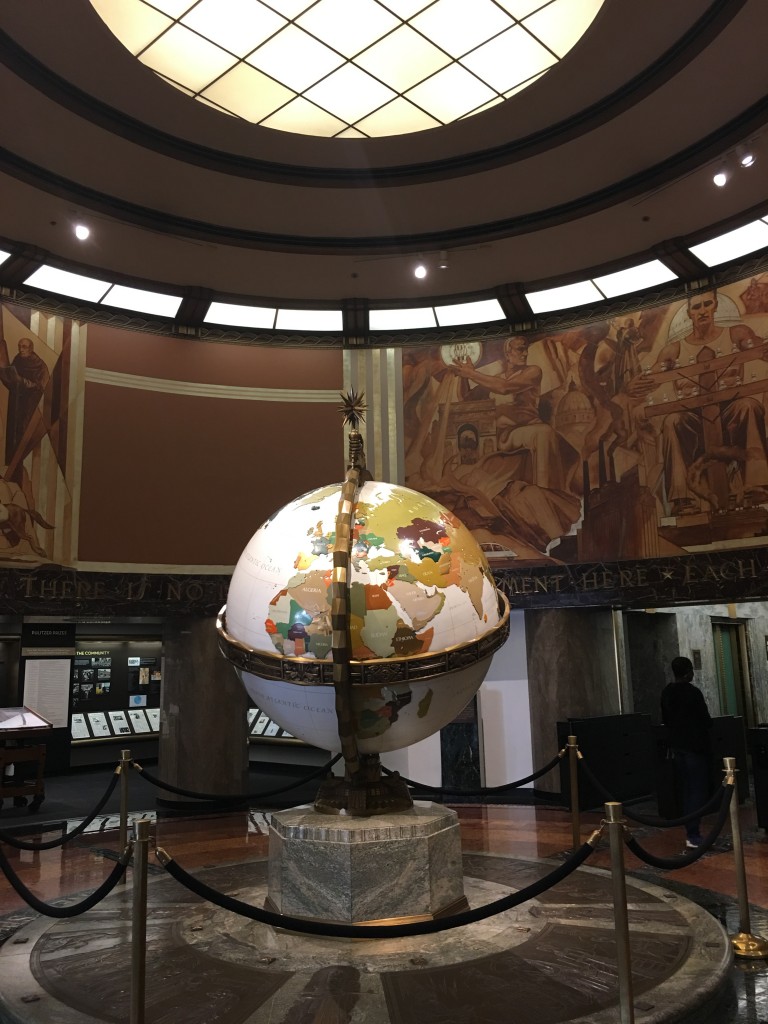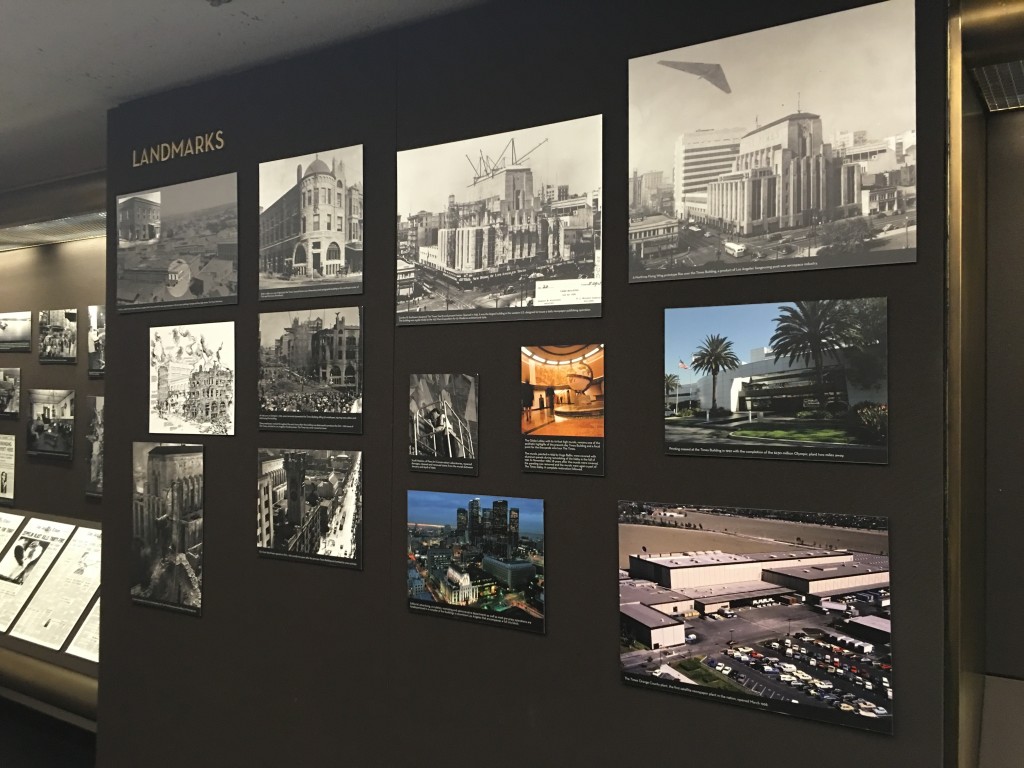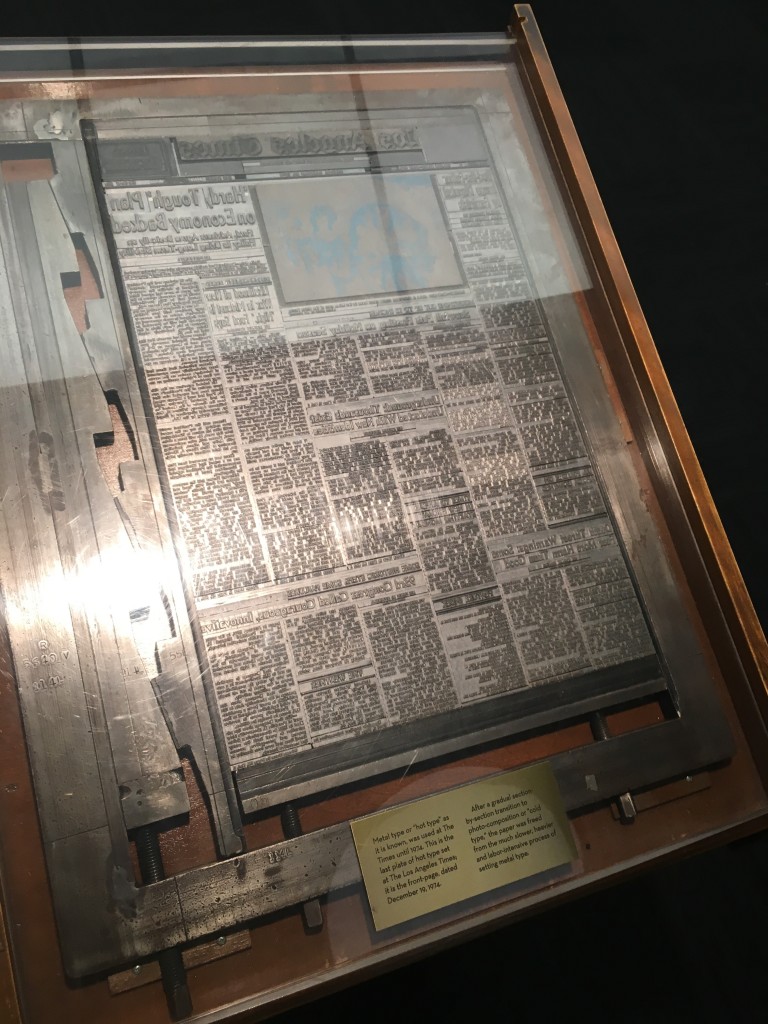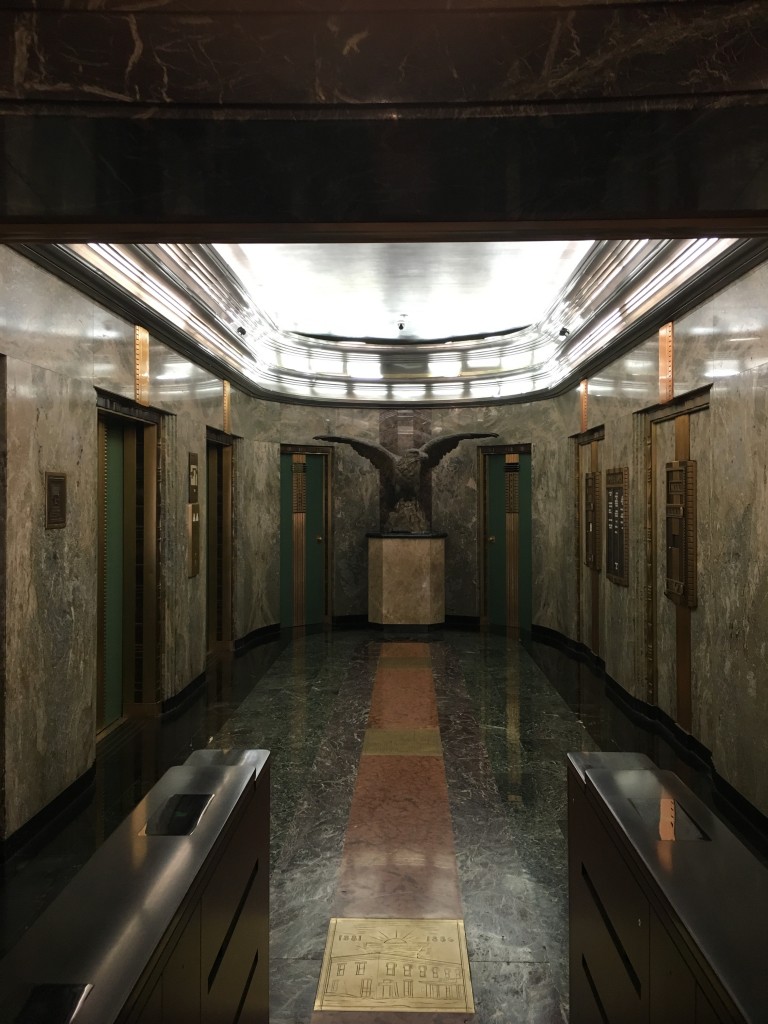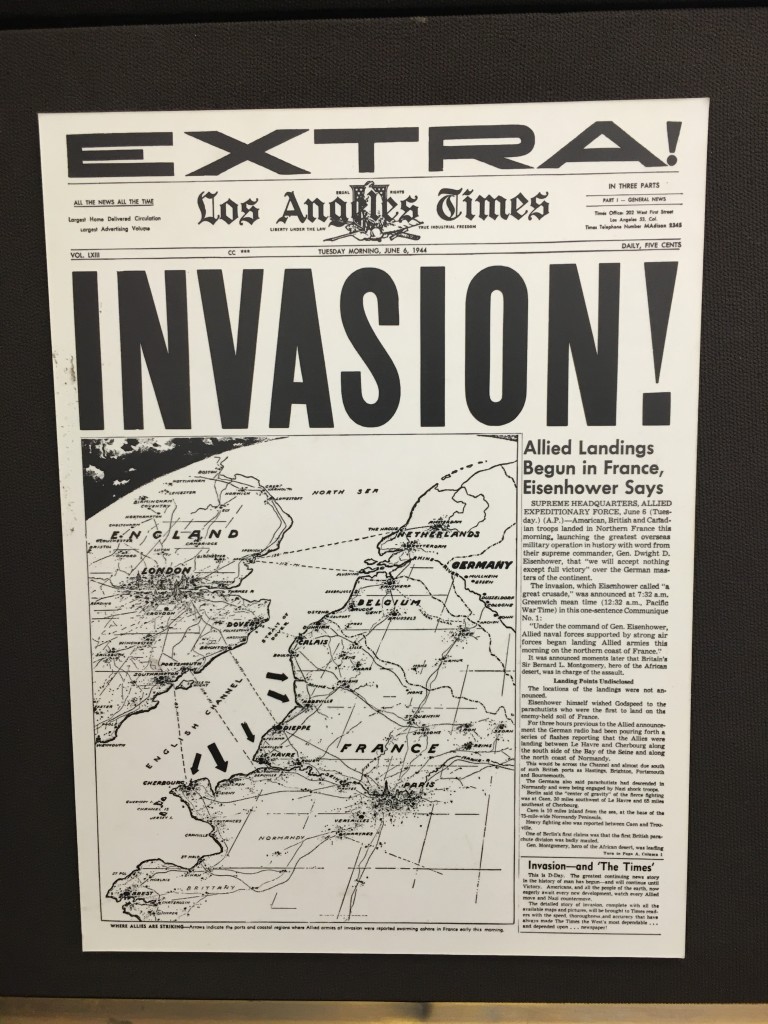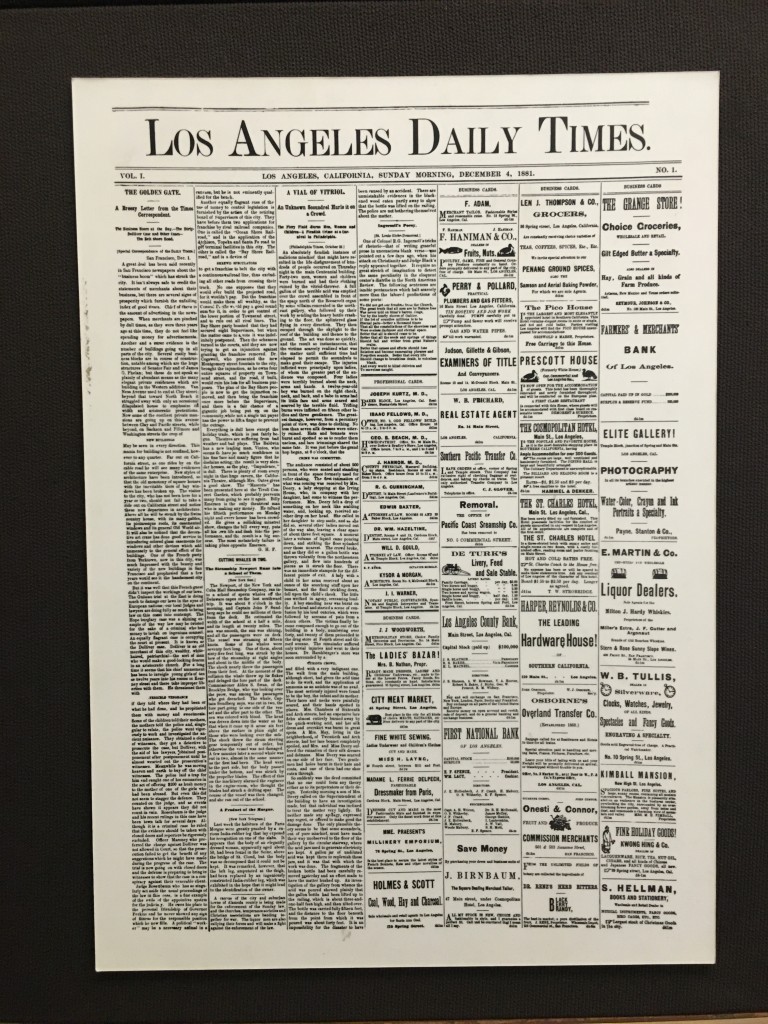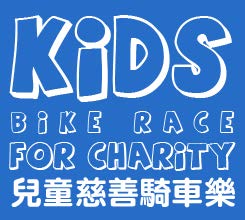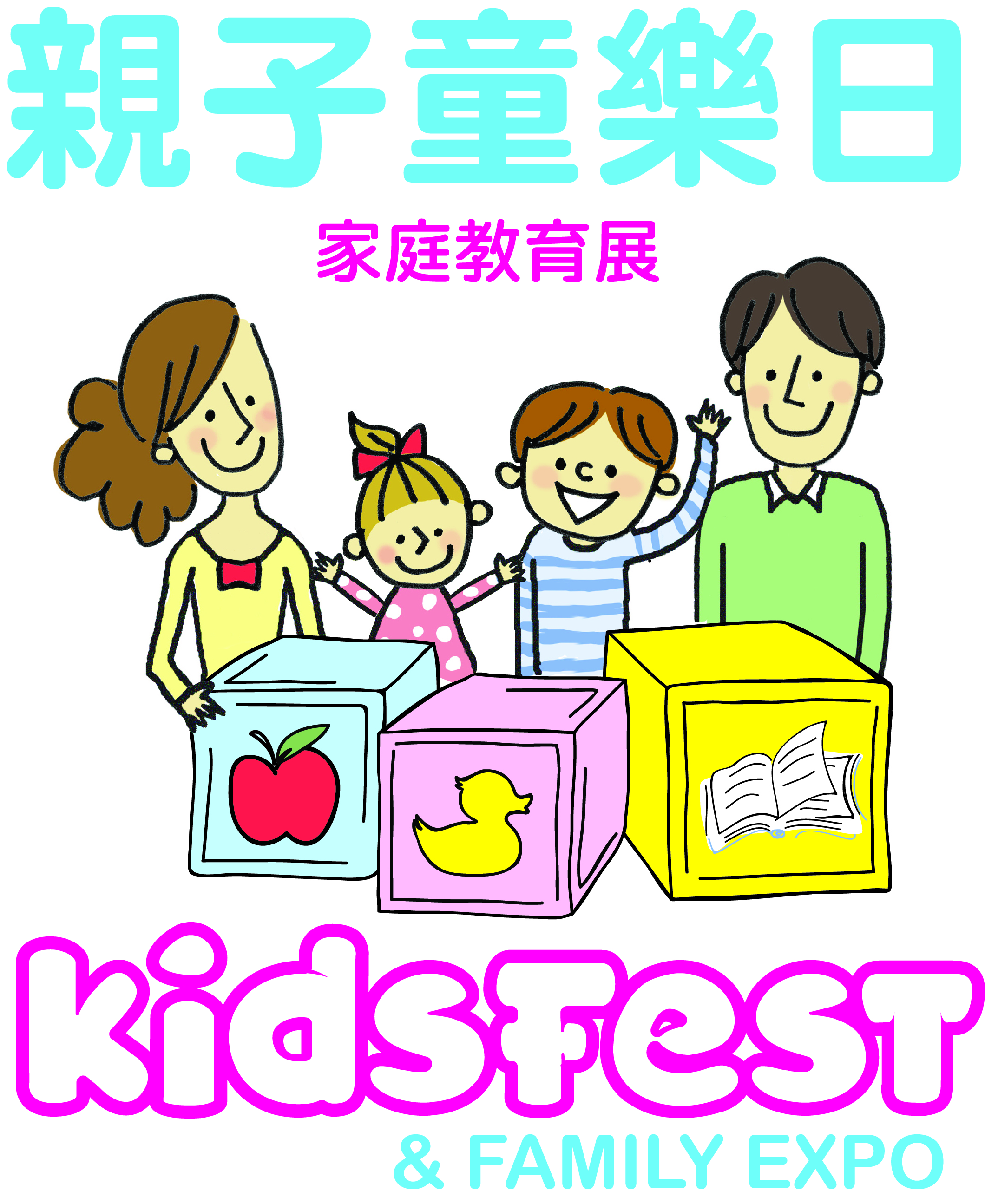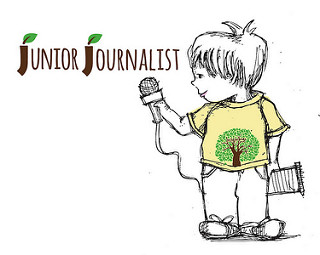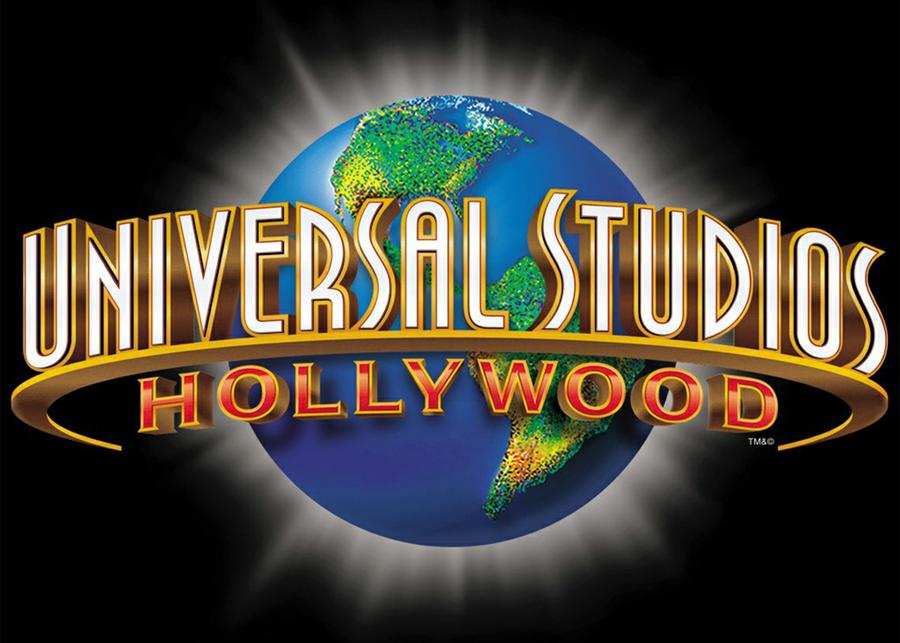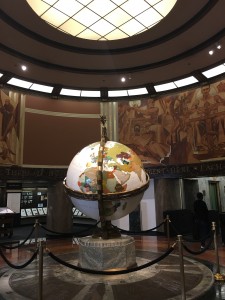 剛剛公佈的新聞界最高獎項~~普立茲獎,洛杉磯時報又獲得了多個重要獎項,再次印證了Los Angeles Times 作為美國重要媒體的地位。身為丫丫小記者,當然要認識這個舉足輕重的媒體所扮演的角色,更要知道一份報紙是如何從採訪到編輯到印刷出版的過程。
剛剛公佈的新聞界最高獎項~~普立茲獎,洛杉磯時報又獲得了多個重要獎項,再次印證了Los Angeles Times 作為美國重要媒體的地位。身為丫丫小記者,當然要認識這個舉足輕重的媒體所扮演的角色,更要知道一份報紙是如何從採訪到編輯到印刷出版的過程。小記者們今年的 Spring Break 過的很不一樣,因為大家特別來到downtown 重要地標~~洛杉磯時報大樓和印刷廠參觀學習!一起來看看他們的感想和照片吧!
洛杉磯時報(Los Angeles Times)是美國發行量最大的報紙之一,創刊於1881年,至今已有135年歷史。位於洛城市中心的大樓非常有歷史感,從大門到入口大廳和電梯大堂,都充滿了上世紀二十年代的風味,大廳兩旁更是擺滿了報紙百多年來的經典報刊頭版和重要版面,還有古老印刷機供人參觀。
【公眾參觀】
洛杉磯時報在平日(周一至五)開放公眾參觀,但只接受 8歲或以上小朋友參加,並須要有一組小朋友同去才會成團。小編在這裡建議家長和小朋友可以在暑假或學校特別放假時,可以預約參觀,裡面的歷史性建築和有關報紙的百年歷史都是小朋友在學校學不到的知識,也是童年時最不能錯過的參觀地點之一喔!
充滿歷史感的大廳和電梯大堂
洛杉磯時報多年來獲得的普立茲獎名單 / 1881年第一份報紙頭版/1944年二次大戰盟軍登陸諾曼第的新聞頭版
大廳展覽室掛滿了洛杉磯時報多年來的重要新聞版面
超過百年歷史的退休老印刷機
Karen Shi
What’s black and white and red all over? The newspaper, of course! It’s black and white, and read all over. Get it?
On March 30, 2016; four Lajaja Kids Junior Journalists went to a tour at the LA Times printing and press headquarters. The LA Times is the largest metropolitan daily newspaper in the whole country, with many Pulitzer-Prize-winning reporters! It provides information on the latest daily news, politics, sports, entertainment, etc. About 4.1 million people read their news each week.
The publishing headquarters have a very unique design and structure. Most of the history of the newspaper is displayed in the lobby, where a gigantic globe stands in the middle of the room. There is also an old-fashioned linotype (typewriter) on display, complete with a copy of print 100 years ago! On the walls hang a timeline of the history and founding members of the La Times. Harrison Gray Otis was the founder of the La Times from 1882-1917, followed by publishers Harry Chandler, Norman Chandler, Otis Chandler, all the way to present day publisher Timothy E. Ryan. The publishers all worked to make the La Times the successful newspaper it is.
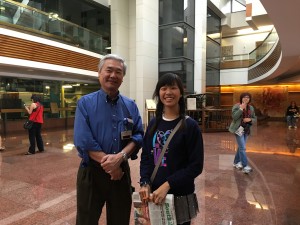 Almost all the hallways of the publishing headquarters are lined with photographs and small captions. Many of the framed photos are by Carolyn Cole, who captured many scenes from wars, hurricanes, fires, and other disasters. Some other pictures are of landscapes, such as the famous picture of the “Moon-Bow,” a rainbow made from a waterfall, captured at night. If you go to the lobby elevator, you can see the La Times giant eagle, a large statue of an eagle. The marble walls of the room where the eagle is located in is very expensive. Flecks of gold can actually be found inside the walls!
Almost all the hallways of the publishing headquarters are lined with photographs and small captions. Many of the framed photos are by Carolyn Cole, who captured many scenes from wars, hurricanes, fires, and other disasters. Some other pictures are of landscapes, such as the famous picture of the “Moon-Bow,” a rainbow made from a waterfall, captured at night. If you go to the lobby elevator, you can see the La Times giant eagle, a large statue of an eagle. The marble walls of the room where the eagle is located in is very expensive. Flecks of gold can actually be found inside the walls!
The tour learned that the editors used Webster Dictionaries to find words to use in texts, and also use the book “Elements of Grammar and Usage.” The Times only prints one paper a day, meaning there are no specific morning or afternoon papers. Instead, they are classified and printed by day of the week. The Sunday edition usually gets the most reads, by average about 2.1 million readers that day of the week. Many of the headlines for the La Times won Pulitzer Prizes, such as Laura Dominick’s headline for the beach “Shore Feels Good!”
After a quick lunch, the tour met up at the printing plant for the LA Times, the Olympic Printing Plant. There is so much paper there that it is impossible to say how many miles total the papers reach. One roll of paper can weigh from 400 to 2400 pounds! A medium sized roll weighs about 1508 pounds. Only robots and lifting machines can lift something that heavy. That’s what they use at the printing center. Robots carry the rolls to their positions inside the printing machine. These robots have been developed over time. Their first generation dated back to 1981. Once the papers go into the machine, they start the roll upward. The paper goes through a slot on the roof, entering the inking machine on the second floor. To print the newspapers, twelve machines are needed to complete the process. Imagine how much ink they need to print that huge amount of paper! Luckily, the LA Times keeps a large supply of recycled ink in a room they use to store it. And the Olympic Printing Plant doesn’t print copies for just the LA Times, but prints for the San Diego Times too! The papers all get categorized by machines and they are stapled by hand, stacked, and delivered.
Needless to say, everyone learned a lot on this tour. We learned how it is at the editing offices, explored the LA Times headquarters, and viewed the printing plant for all the newspapers. This has been one of the best tours in my life, and I hope to go there again in the future. You can tour the LA Times too! Visit LA Times’ official website www.latimes.com for more information.
Ryan Lin
The Los Angeles Times is a leading source of breaking news, entertainment, sports, politics,food,travel and more for Southern California and the world. On April 8th 2016. I went to Los Angeles Times Tour. Our tour guide was Darrell Kunitomi. First off, he told us the history of the LA Times building. It was founded in year 1881 by a guy name General Harrison. He was a soldier, but became a publisher. Next owner was a powerful, rich guy named Harry Chalder. After General Harrison died, he gave his company to Otis Chandler the LA Times. Later when Otis change how the newspaper looked, the family voted him out of his place in the Los Angeles Times. The LA Times building was in the 20’s and the 30’s. A famous architect name Gordon Kaufmann made and design the LA Times building. He also designed the Hoover Dam, the mascot for the LA Times (the eagle) and the Santa Anita Race Track.
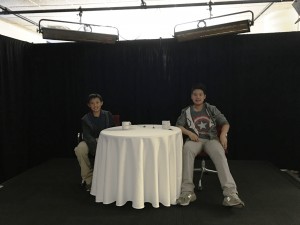 The second floor is about pictures and editing. They can take many sorrowful pictures, but they don’t like put the heartbreaking ones on their news. Only if it is meaningful and world news they will published. We saw many perfect timed pictures, one of them is in the Yellowstone National Park. It was a beautiful night sky with a rushing waterfall with an upside down moon bow. We went to the broadcasting stage where they do interview and weather castings. There is also a sport broadcast stage that talks about sport news.
The second floor is about pictures and editing. They can take many sorrowful pictures, but they don’t like put the heartbreaking ones on their news. Only if it is meaningful and world news they will published. We saw many perfect timed pictures, one of them is in the Yellowstone National Park. It was a beautiful night sky with a rushing waterfall with an upside down moon bow. We went to the broadcasting stage where they do interview and weather castings. There is also a sport broadcast stage that talks about sport news.
Next we are off to travel, fashion and best of all food. Reporters travel around the world looking for new things like culture, food, clothing, and many other things. For Fashion there were many people in nice looking clothes. Next is Food on the newspaper. All the food that chef writes down and is going to be put on paper has to be tested. All the recipe has to be real and approved. The third floor with the food section was the most interesting part of the tour. It had a giant gingerbread surf shack made from comply out of food and looks very tasty.
Editors or reporters can either choose or not choose the story they are going to write on the newspaper. They usually write about a topic that is really shocking or really interesting news, but they prefer it to be a happy story not a tragedy one. Mr. Kunitomi told us LA Times publishes about 400,000 newspaper a day! There is about 50 pages up and down in one set of newspaper. On Sunday there is about 100 pages and Monday is about 36 pages. I learned a lot interesting facts about the LA Times and its history today! I was really lucky to receive a Front Pages book from Mr. Kunitomi. This book is the collection of Los Angeles Times front page is a wonderful look into the history of Los Angeles and the world at large that I can’t stop reading it!
Kyle Chiu
On March 30, the Lajaja Kids Junior Journalist went to the L.A. times and had a tour around the buildings. Darrel Kunitomi, our tour guide, showed us many things about this place.
The first stop was at the Globe Lobby where the history started by General Harrison Gray Ottis who was a real general in 1881 when his paper was printed. Then the second followers were Harry Chandler who married Dorothy Buffum Chandler and his son Norman Chandler. Back then they used the Pony Express to deliver their papers. The Times Eagle was made in 1898 made by Borglan.
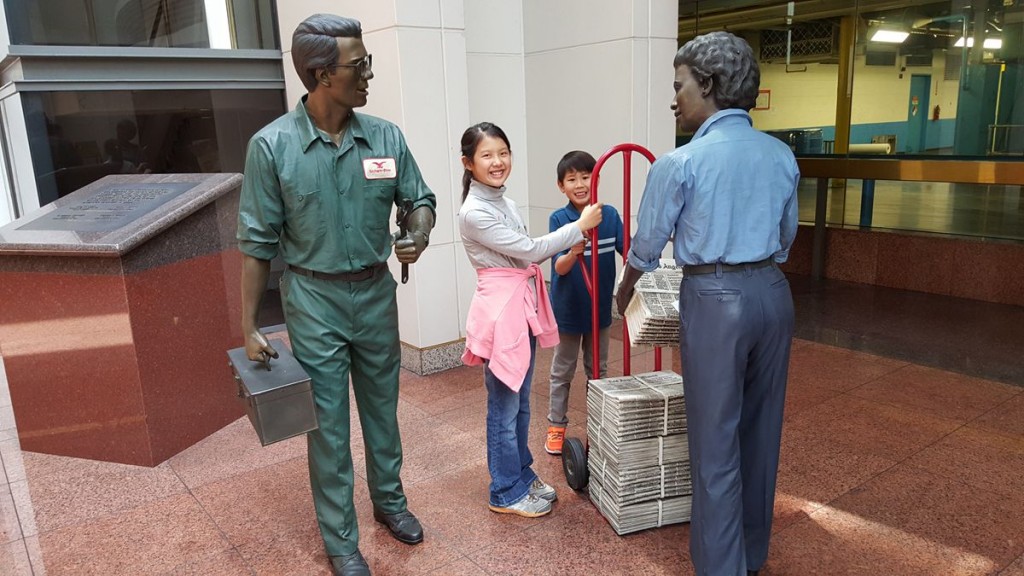 Then we started the Editorial level where the reporters bring back stories or essays about food, news, advertisement, and many other things we usually know about. There was also a food trying room for the editors to taste the food that they post on the news. There were many kinds of editors in the level.
Then we started the Editorial level where the reporters bring back stories or essays about food, news, advertisement, and many other things we usually know about. There was also a food trying room for the editors to taste the food that they post on the news. There were many kinds of editors in the level.
The next stop we went was the photo or picture room. The pictures showed all kinds of things in the world and a few of the pictures were from cameras from the 1900s. Some of these pictures took lives to take. These pictures were sad, scary, sad, and funny, such as the one with the dog riding a guy when he was biking. Other feelings you will get when you see the pictures.
The last stop in the editorial building was the publishing and printing room where the papers were printed and publish and all of the machines there had back up and the papers were about to be sent to our houses. This was only half of our trip through the L.A. Times tour.
The second half of the tour was in the Olympic Printing Plant. This is the working place that newspapers were made. In the first stop it was where the papers were stored and put in place by robots. The papers all came from the next room was full of blank paper shipped from all over the world. The papers were 2-3 pages wide and they were at least 6 miles long a role. The papers were more than 1,000 pounds for each roll. The people and machines carried them up in sacks and made the stacked papers like a forest.
T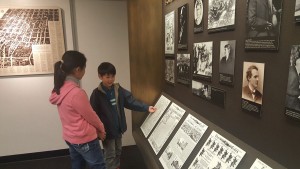 he room after the paper room was where the newspaper were printed and folded. There were copies of all kinds of newspapers even some from New York. The printers of course involved ink so there was an ink room. The ink room was much smaller than the other rooms in the building. There are many different color cans of ink in the room and it looks dirty.
he room after the paper room was where the newspaper were printed and folded. There were copies of all kinds of newspapers even some from New York. The printers of course involved ink so there was an ink room. The ink room was much smaller than the other rooms in the building. There are many different color cans of ink in the room and it looks dirty.
The last room in the tour of the day was a room the papers were about to be sent. The machines were used to fold and pack the papers away. Then all the papers were sent away delivered by people and at our houses after a few days.
After the tour I feel like it is my pleasure to go to such a famous newspaper company and if I can go there again, I would be very delighted to go.
Anthony Zhang
Walking tour of LA times Olympic Printing Plant
On a rainy Saturday, I took a guided tour of LA times Olympic Printing Plant.
First I saw the initial volume 1 front page of LA Times dated on December 4, 1881. I also saw that their warehouse with many rolls of paper. According to our tour guide, they used more than 300 rolls of paper every day. Each roll of paper is between 1700 to 2000 lbs. There were many robotic loaders driving around guided by laser beam.
Next, we went the place where the newspaper was made. They used a lot ink to make the newspaper, but they also recycle those dirty inks. They have to clean the machine that place the ink on the paper by hand, which is very dirty after the printing. They must be shiny after cleaning.
Finally, we saw how color page was made. They only use the black, yellow, green, and red to make all the colors. Once printed, the newspaper gets in the “folder” and gets in stacks after it gets in the machine. Then it was stockpiled in different areas and waiting to be shipped to many places.
My trip was awesome, and have you ever experienced anything like mine?
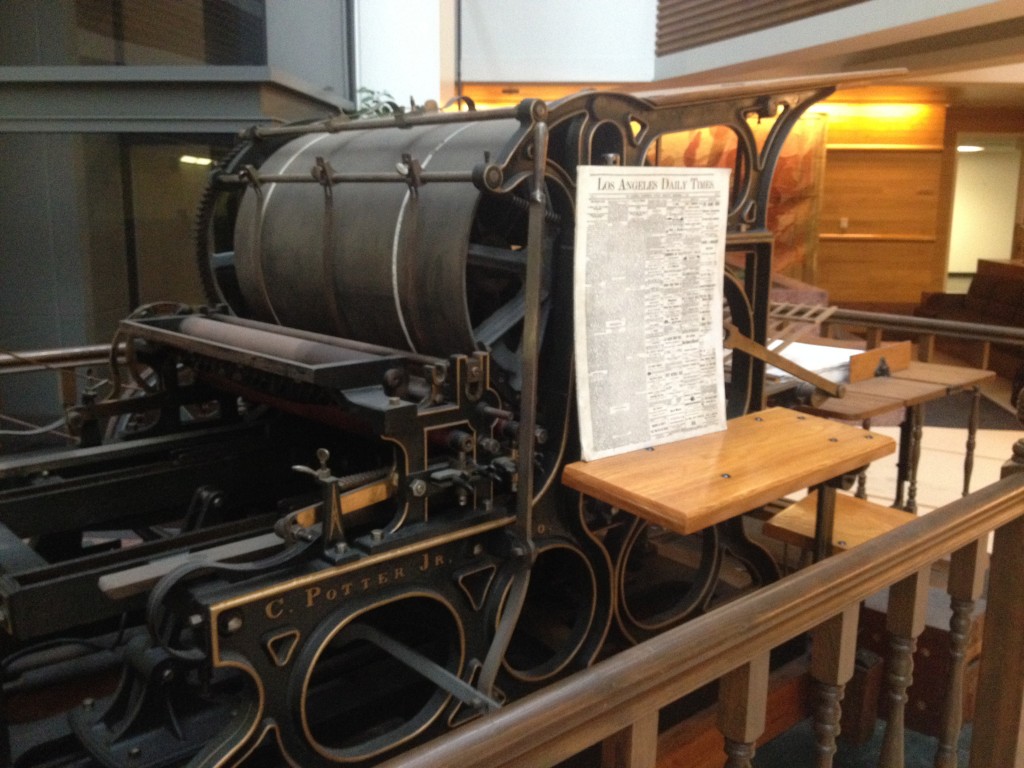
Bianca Chiu
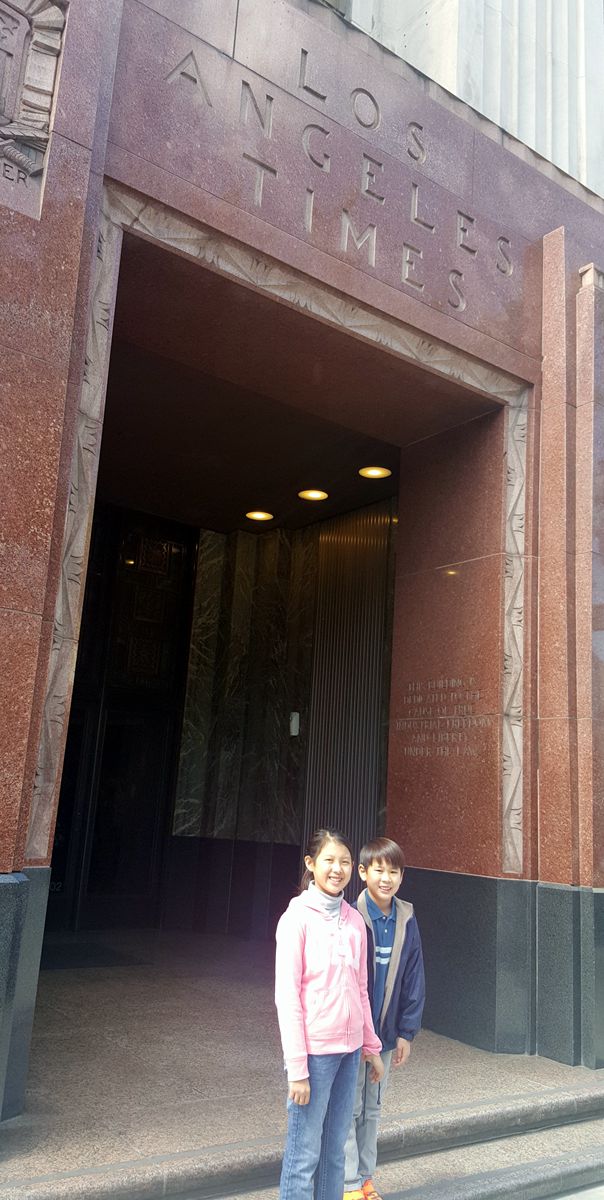 Millions of paper rolls, hundreds of jars of ink, and humongous printing presses, it’s all there at the L.A. Times building built by Julia Morgan, the place which four L.A.JaJa Kids Junior Journalists visited on March 30, 2016 (Wednesday).
Millions of paper rolls, hundreds of jars of ink, and humongous printing presses, it’s all there at the L.A. Times building built by Julia Morgan, the place which four L.A.JaJa Kids Junior Journalists visited on March 30, 2016 (Wednesday).
It all started successfully with the first paper published by General Harrison Gray Otis on December 4, 1881, under the directions of Nathan Cole Jr. and Thomas Gardiner. L.A.ter on, Otis decided to move from Santa Barbara, and became the company’s editor. The next publisher of the Times was Harry Chandler, followed by his son Otis Chandler, who transformed the company and brought a modern sense to the papers, making them more popular (though Otis Chandler was voted out of the company L.A.ter on). Not long after, Gutzon Borglum, who is mainly famous for creating the Mount Rushmore National Memorial, sculpted the first Times eagle for the company.
In the building, you may find a lot of remarkably (though sometimes creepy) close-up photos of things and people like soldiers during a battle and Hurricane Katrina. These pictures were made possible by the exceptional work of Carolyn Cole, the brave, daring photographer who ventured towards battlefields and storm sites just to take a favorable photo. One time, Cole fearlessly sneaked into a church used for resting/wounded soldiers during a war to capture a picture of them. Later on, after staying unseen for a while, she knew that, once she left, she would be deeply searched, so she handed her camera’s memory card to an ally, who brought it back safely. And sure enough, when Cole left, she was given an intent search on her way out.
After being introduced to the wonderful works of Carolyn Cole and some other photographers, the journalists were brought to a set used for webcasting by their tour guide Darrell Kunitomi. Webcasting, for the Times, is another important part of their business. Some people may not read the paper, and, instead, head to LATimes.com to watch videos such as these to here about the latest news. According to the company, a newspaper and digital clips go together, supporting each other. Darrell also informed us on how the Times has won many awards, including the 2010 Headline Writing Award, with Laura Dominick’s headline “Shore Feels Good”.
The food section was one of the journalists’ favorites. It is where employees work to cover stories about foods and teach recipes. It comes with everything delicious like a pretzel house and a test kitchen, used to make the foods described in the recipes for the photos in the papers, for the LA Times would NEVER fake a food for the pictures (they really never should).
Exiting the main building, the journalists independently headed towards the location in which the second part of the tour would take place, the Olympic Facility part of the Times.
The second building is mainly for making the papers. When the curious journalists entered, they were welcomed by gigantic rolls of paper, most of them over 5 miles long. (For every 3 miles, you can make 8,640 papers, with each being 22 inches.) Since the paper can weigh from 800~4,200 pounds, they are moved around by robots that move automatically and change their batteries by themselves.
Afterwards, Darrell led his group into the inky room occupied with printing presses. These machines come in units, and 12 units make up a press. After the papers are printed, they are transported to another department for delivery by a machine that clips on the paper with yellow clips. Though, some of the papers may fall down, most of them make it.
This experience was valuable for everyone on the tour, and it might’ve even inspired some of the journalists to become real reporters for the Times someday!
Los Angeles Times Tour
by Kyran
On April 8,2016, 2 Lajaja Kids junior journalists (Ryan and I) went to the LA Times tour. The tour started at Globe Lobby, the one of the highlights of the Times Building. The lobby includes an historical exhibit showcasing the first 100 years of The Times. There was an eagle carved by George Kaufman. Our tour guide was Darrell Kumitomi. He told us about the history of LA Times.
LA Times don’t just do tragedy news they also have fun stuff like food, sports, fashion, travel ,comics, music ,movies, books and many more. They have many photos on hallways wall took by the journalisms. Many of them were sad photos. Mr. Kumitomi told us the story for some of photos. My favorite photos is a dog on a man’s back riding a bike in the valleys. That look so cool! There’s another one that was a picture of a moon bow! A moon bow is a rainbow but is made of a full moon. They have to expect new words for it.
The most interesting section to me is food section. They have to test all the new recipe it in their test kitchen before publishing the recipe on the newspaper. The test kitchen looks like a fancy house kitchen with all the things they need for the new recipes.
At the end of tour, Ryan asked Mr. Kumitomi about how many newspaper LA Times publishes each day? He told us about 400,000 newspaper a day. Wow! That was surprise me. This tour takes me into history of the LA Times and I learned so many interesting facts about it.
